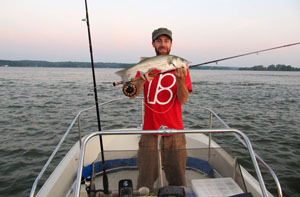EDITORS’ NOTE: This will have a positive and measurable impact on the entire Chesapeake fishery.
Oyster Recovery Partnership Restored Oyster Reef Shows Highest Denitrification Rate of Any Natural System Documented in the Chesapeake Bay
One of Highest Ever Reported in a Marine Environment; Opens Possibility that Oysters Conducive for Nutrient Control
 [dropcap]A[/dropcap]group of Chesapeake Bay researchers have published a groundbreaking study in April’s issue of the Marine Ecology Progress Series Journal with findings that indicate restored oyster reefs could have greater impacts on estuarine water quality than previously thought, refining our understanding of the role that restored oyster reefs play in removing excess nutrients from large estuaries like the Chesapeake Bay.
[dropcap]A[/dropcap]group of Chesapeake Bay researchers have published a groundbreaking study in April’s issue of the Marine Ecology Progress Series Journal with findings that indicate restored oyster reefs could have greater impacts on estuarine water quality than previously thought, refining our understanding of the role that restored oyster reefs play in removing excess nutrients from large estuaries like the Chesapeake Bay.
In a study funded by the Oyster Recovery Partnership and GenOn Energy (now NRG Energy), scientists Lisa Kellogg of the Virginia Institute of Marine Science, Jeff Cornwell and Mike Owens of the University of Maryland Center for Environmental Science and Ken Paynter of the University of Maryland, College Park estimate that an acre of successfully restored oyster reef could remove 543 pounds of nitrogen in the Choptank River in just one year through denitrification. In addition, they found that the restored reef provides habitat for more than 24,000 organisms per square meter.
 “Although this is just one site, these rates are gigantic,” said Cornwell. “Compared to adjacent sediments, what happens in a square meter of oyster reef might be magnified 30 or 40 fold in terms of nutrient processing due to the structure of the reef and the diverse community of organisms the oyster reef supports.”
“Although this is just one site, these rates are gigantic,” said Cornwell. “Compared to adjacent sediments, what happens in a square meter of oyster reef might be magnified 30 or 40 fold in terms of nutrient processing due to the structure of the reef and the diverse community of organisms the oyster reef supports.”
Denitrification is the process of converting unwanted nutrients into a harmless nitrogen gas — the most common element in our atmosphere. This is the same process utilized by wastewater treatment plants to remove nitrogen from human waste. In this case, oyster reefs in tributaries could provide important protection against unwanted/excess nutrients from reaching the Chesapeake Bay’s main stem thereby promoting better water quality.
As part of the project, researchers calculated the potential nitrogen removal by successfully restored mature oyster reefs to all currently viable areas within the Choptank River. If high-density, mature oyster reefs were restored to all 4,256 acres of suitable area in the Choptank, they could remove nearly 50% of the river’s total delivered nitrogen load through denitrification.
“This study clearly lays the groundwork for oysters to be recognized as more than just a filter feeder, habitat creator, and good source of nutrition,” said Stephan Abel, Executive Director of the Oyster Recovery Partnership. “Oysters have the potential to play a critical role as a Best Management Practice (BMP) in achieving the Bay’s Total Maximum Daily Load (TMDL) goals and addressing the long-standing nutrient and sediment impairments currently impacting the Chesapeake Bay and its residents.”
[information]
For full scientific report visit the following link: Denitrification and Nutrient Assimilation on a Restored Oyster Reef
Sarah Walker
Oyster Recovery Partnership
1805 A Virginia Street
Annapolis, MD 21401
410-990-4970 – Office
Website: www.oysterrecovery.org
[/information]


